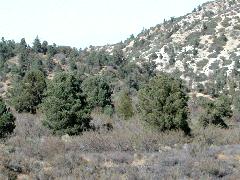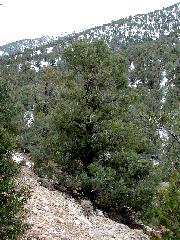Single leaf Pinyon Pine - Pinus Monophylla
Site Characteristics
|
Singleleaf pinyon is adapted to a wide variety of sites. It usually grows on pediments,
dry, rocky slopes, ridges, and alluvial fans and is rarely found on valley
floors.
It is frost resistant, tolerant of drought, and requires full sunlight for maximum growth. On favorable sites, the woodland may form a dense cover with trees 30 to 40 feet (9-12 m) tall. On drier sites spacing widens and tree size diminishes. |
 |
At the northern end of its range, singleleaf pinyon is found primarily on south-facing slopes and outcrops of decomposed granite. At the southern end of its range it occurs only on north-facing slopes.
 Pinyon at 6,800 ft. |
Elevational range of singleleaf pinyon is generally 3,280 to 9,186 feet. In Baja and parts of southern California it may be found below 3,280 feet. The lower elevational limit in the high desert of the Great Basin is just above the elevation of the adjacent valleys, varying from 4,987 to 6,988 feet. The upper limit of singleleaf pinyon varies with climate and competing tree species, but it has been found as high as 10,000 feet in the White Mountains of California. |
Singleleaf pinyon is the most xeric pine in the United States. Its mean annual precipitation range is 8 to 18 inches, with most precipitation falling December through April. Its mean annual air temperature is 50 degrees Fahrenheit (10 °C), ranging from 21 degrees Fahrenheit (-6 °C) in January to 86 degrees Fahrenheit (30 °C) in July. Annual stem growth, needle length and percentage of double-needled fascicles all had significant positive correlations with annual precipitation received prior to the completion of each year's growth.
Mature singleleaf pinyon is not shade tolerant; however, water rather than light is the limiting factor in survival and growth of this species. Results of a Nevada study suggest that the ability of singleleaf pinyon to exist on a wide range of environmental conditions is not a function of variable ecophysiological responses, but an opportunistic response to the availability of resources and conditions suitable for growth.
-- General Distribution
Elevation and precipitation ranges are as follows:
State - Elevation, Precipitation
Utah - 2,690-9,700 feet, 12 inches
Nevada - 4,900-9,500 feet, 12 inches
California - 3,000-10,000 feet
Arizona - 4,500-7,500 feet, 12-22 inches
New Mexico - 4,500-7,500 feet, 12-22 inches
Idaho - 5,500-7,400 feet,
Mexico - 3,500-6,600 feet, 12-24 inches
-- Soil Types
Singleleaf pinyon typically grows on shallow, well-drained, low fertility soils, although it has been found on more productive soils as well. Singleleaf pinyon in shallow soils tend to grow more slowly than those in deeper soils. Surface soil pH usually is between 6.0 and 8.0. A study in the Great Basin found singleleaf pinyon was most common on granitic parent material (33% cover), followed by alluvial parent material (9.5% cover), and finally limestone parent material (0.3% cover). It was not found on quartzite or sandstone. Singleleaf pinyon was most commonly found on soils that contained 15-35% skeletal material by volume.
While singleleaf pinyon can grow on a wide variety of soil types and environmental conditions, composition and distribution of associated understory species may be driven by the plants' position relative to the tree crown, soil type, the seasonality and effectiveness of precipitation, and/or the distribution of nutrients.
Next >
< Previous